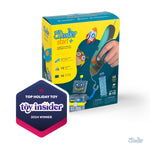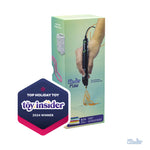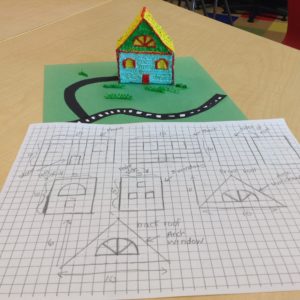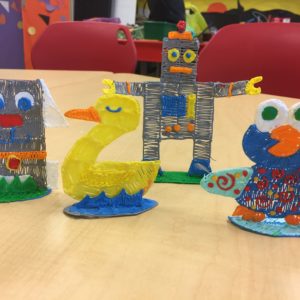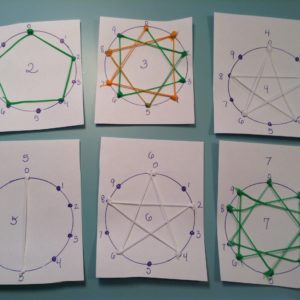Doodler Tree Anglers
In this activity, students will work in pairs to doodle a forked tree limb. They will use the tree limb they create to find the angles, determine the type of triangle created when a third side is added, and determine whether it is possible to draw more than one triangle.
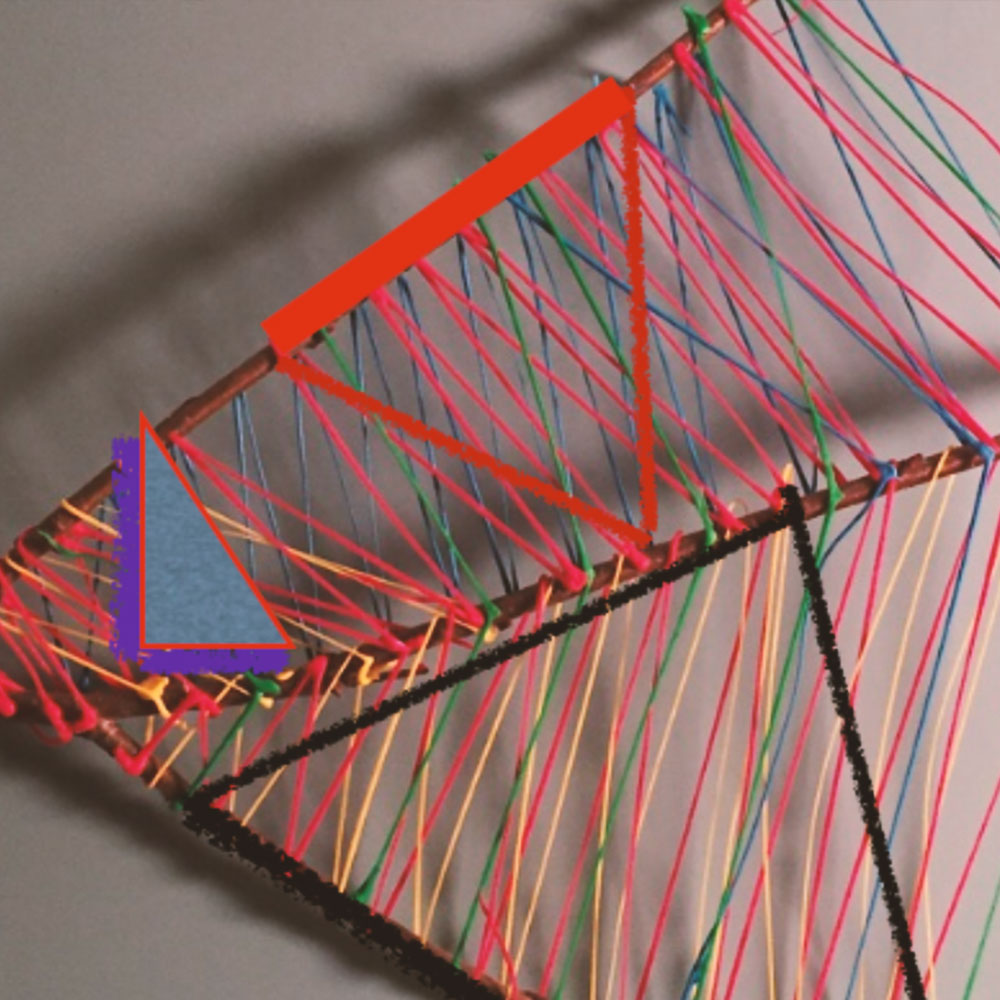
KnowledgeStudents havepracticed identifying different types of triangles, e.g, attributes of equilateral, isosceles, scalene, right triangle, acute, and obtuse triangles.
practiced labeling angles as seen here.
practiced measuring angles with a protractor.
practiced identifying intersecting and congruent lines.
practiced with a 3Doodler using the wrapping technique to wrap the Eco-plastic around a pencil or another thin, elongated object, e.g., dowel, stick.
practiced identifying different types of triangles, e.g, attributes of equilateral, isosceles, scalene, right triangle, acute, and obtuse triangles.
practiced labeling angles as seen here.
practiced measuring angles with a protractor.
practiced identifying intersecting and congruent lines.
practiced with a 3Doodler using the wrapping technique to wrap the Eco-plastic around a pencil or another thin, elongated object, e.g., dowel, stick.
ObjectivesStudents willrecognize lines that meet and/or intersect.
recognize congruent lines.
doodle a third line to doodled angles in order to make triangles.
recognize what would make it possible to draw one or more than one triangle with these given conditions.
recognize conditions that would make it impossible to draw a triangle.
explain their reasoning about conditions that are possible or impossible.
recognize lines that meet and/or intersect.
recognize congruent lines.
doodle a third line to doodled angles in order to make triangles.
recognize what would make it possible to draw one or more than one triangle with these given conditions.
recognize conditions that would make it impossible to draw a triangle.
explain their reasoning about conditions that are possible or impossible.
MaterialsStudents will need3Doodler (1 per pair)
forked tree branch (1 per pair)
protractor (1 per pair)
pencil (1 per student)
large sheet of bulletin board paper (1 per pair)
metric ruler (1 per pair)
3Doodler (1 per pair)
forked tree branch (1 per pair)
protractor (1 per pair)
pencil (1 per student)
large sheet of bulletin board paper (1 per pair)
metric ruler (1 per pair)
Lesson PlanInstructions
Step 1 - PREPARATIONAsk students to bring in 2-3 forked tree branches from home between 10-14 inches in length.
Project Geogebra on the board for students to view.
Step 2Share the goal: Students will use a 3Doodler to wrap their branches in Eco-Plastic, using a winding motion around the branch to create different types angles as they go. Demonstrate how to do this with a branch and 3Doodler.
Step 3Point out the angles that have been created. Note how some are obtuse, while others are acute. Some have longer sides. Others have shorter sides.
Step 4Share the goal: Students will note the conditions, i.e., 3 angles or 3 sides, that make it possible or impossible to form a triangle.
Step 5Use a protractor and metric ruler to measure 3 different sides and angles spread out on your branch and record their measurements (sides and angles) in the Doodler Angler Journal.
Step 6Demonstrate how to doodle a third line to make a triangle out of each angle. Measure and record its length in the Doodler Angler Journal.
Step 7Ask students, "True or False: All angles can form triangles."
Step 8Allow students to test this statement using Geogebra as a whole group. Test out various angles and line lengths to check and verify.
Will the lines always meet? Or do some angles form congruent lines that never meet?
Step 9In the Doodler Angler Journal, challenge students to record three conditions which make it
a) possible to doodle one unique triangle,
b) conditions which are possible to doodle more than one triangle, and
c) conditions in which it is impossible to doodle a triangle.
Step 10Clean off the branches. Instruct students to demonstrate the three conditions using a 3Doodler and branch.
Step 11Circle to assist and assess.
Ask students to bring in 2-3 forked tree branches from home between 10-14 inches in length.
Project Geogebra on the board for students to view.
Share the goal: Students will use a 3Doodler to wrap their branches in Eco-Plastic, using a winding motion around the branch to create different types angles as they go. Demonstrate how to do this with a branch and 3Doodler.
Point out the angles that have been created. Note how some are obtuse, while others are acute. Some have longer sides. Others have shorter sides.
Share the goal: Students will note the conditions, i.e., 3 angles or 3 sides, that make it possible or impossible to form a triangle.
Use a protractor and metric ruler to measure 3 different sides and angles spread out on your branch and record their measurements (sides and angles) in the Doodler Angler Journal.
Demonstrate how to doodle a third line to make a triangle out of each angle. Measure and record its length in the Doodler Angler Journal.
Ask students, "True or False: All angles can form triangles."
Allow students to test this statement using Geogebra as a whole group. Test out various angles and line lengths to check and verify.
Will the lines always meet? Or do some angles form congruent lines that never meet?
In the Doodler Angler Journal, challenge students to record three conditions which make it
a) possible to doodle one unique triangle,
b) conditions which are possible to doodle more than one triangle, and
c) conditions in which it is impossible to doodle a triangle.
Clean off the branches. Instruct students to demonstrate the three conditions using a 3Doodler and branch.
Circle to assist and assess.
Wrap Up
Assessment
Possible Extensions
Resources
Vocabulary
angles - the space (usually measured in degrees) between two intersecting lines or surfaces at or close to the point where they meet.
collaboration - to work jointly with others or together especially in an intellectual endeavor.
conditions - the state of something, especially with regard to its appearance, quality, or working order.
creative thinking - a way of looking at problems or situations from a fresh and imaginative perspective.
math - the science of numbers and their operations, interrelations, combinations, generalizations, and abstractions and of space configurations and their structure, measurement, transformations, and generalizations.
mathematics - the abstract science of number, quantity, and space. Mathematics may be studied in its own right ( pure mathematics ), or as it is applied to other disciplines such as physics and engineering ( applied mathematics ).
problem-solving - the process or act of finding a solution to a problem.
proofs - in mathematics, a proof is an inferential argument for a mathematical statement.
reasoning - the drawing of inferences or conclusions through the use of reason.
triangle - a polygon having three sides.
Educational Standards
Draw (freehand, with ruler and protractor, and with technology) geometric shapes with given conditions. Focus on constructing triangles from three measures of angles or sides, noticing when the conditions determine a unique triangle, more than one triangle, or no triangle.
Students will attempt to draw triangles based on a given set of conditions involving angles and/or sides. Students will create their own set of conditions for possible or impossible triangles.
Define the criteria and constraints of a design problem with sufficient precision to ensure a successful solution.
Students will attempt to draw triangles based on a given set of conditions involving angles and/or sides. Students will create their own set of conditions for possible or impossible triangles.
Evaluate competing design solutions using a systematic process to determine how well they meet the criteria and constraints of the problem.
Students will evaluate and consider the design solutions of other groups during a shared activity, presentation and discussion.
Define the criteria and constraints of a design problem with sufficient precision to ensure a successful solution
Students will attempt to draw triangles based on a given set of conditions involving angles and/or sides. Students will create their own set of conditions for possible or impossible triangles.
Evaluate competing design solutions using a systematic process to determine how well they meet the criteria and constraints of the problem.
Students will evaluate and consider the design solutions of other groups during a shared activity, presentation and discussion.
Articulate and set personal learning goals, develop strategies leveraging technology to achieve them and reflect on the learning process itself to improve learning outcomes.
Students will attempt to draw triangles based on a given set of conditions involving angles and/or sides. Students will create their own set of conditions for possible or impossible triangles.
Use technology to seek feedback that informs and improves their practice and to demonstrate their learning in a variety of ways.
Students will use a 3Doodler to doodle various types of angles and triangles of varying lengths, thus testing and verifying the mathematical conditions.
Exhibit a tolerance for ambiguity, perseverance and the capacity to work with open-ended problems.
Students will need to create their own possible or impossible conditions.
Communicate complex ideas clearly and effectively by creating or using a variety of digital objects such as visualizations, models or simulations.
Students will use a doodled tree branch to demonstrate possible and impossible conditions.
Use collaborative technologies to work with others, including peers, experts or community members, to examine issues and problems from multiple viewpoints
Students will share a doodled tree branch to demonstrate possible and impossible conditions.
